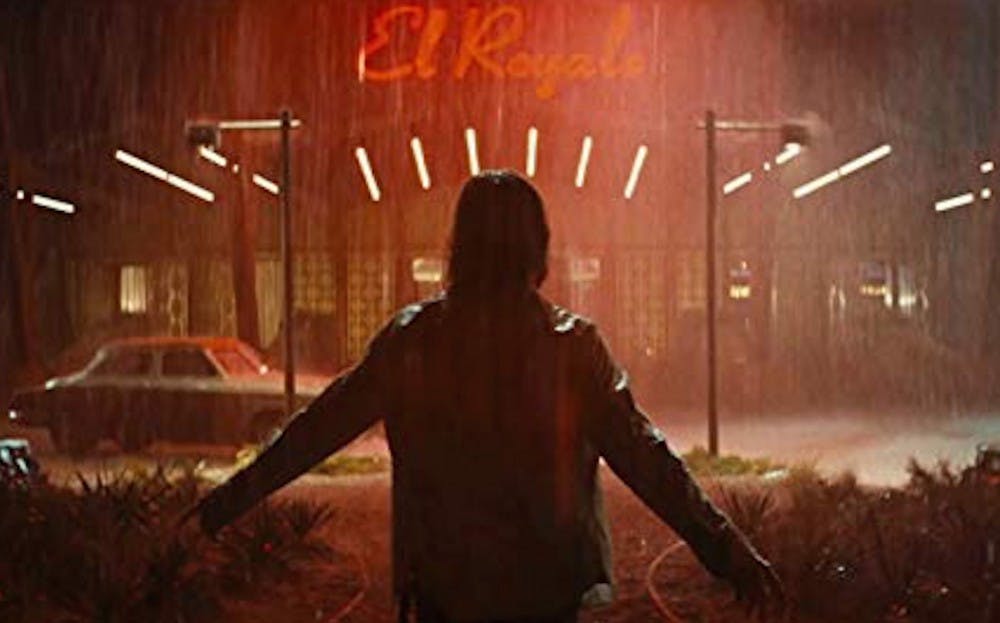What do a racist vacuum salesman, an elderly priest, a young African-American woman and a rude hippie have in common? They are the only customers of the once great El Royale motel, a lodge on the border of California and Nevada. Its unique design puts half of the hotel in California and the other in Nevada, offering its guests luxury and elegance in California and adrenaline and hope in Nevada. This mysterious setting immediately indicates that whatever can happen will happen and that there are always two halves to the whole picture. “Bad Times at the El Royale” is an adventure straight from the start that keeps the audience guessing. Nothing in this film is what it appears to be, and everyone has a secret.
The story is told from the perspective of each guest in a compilation of brief episodes. This method allows for insight into the reason the guests are staying at the El Royale and the motivation for their actions after their arrival. The episodes play off each other and ultimately culminate with an epic climax that reminds the audience all actions have consequences.
"Bad Times" blends the traditional ideals of film noir with the more modern methods of Quentin Tarantino to make a film that is both mysterious and incredibly violent. As a sort of neo-noir film, it embodies many of the traditional characteristics seen in film noirs of the '40s and ‘50s. Films like “Stranger on the Third Floor” and “Double Indemnity,” set out to be strange, cruel and criminal. While “Bad Times”’s format prevents it from becoming a true film noir — as films of the genre are often told from one perspective — other characteristics of the genre are embodied in the film and its characters.
These film-noir ideals are complimented by the use of techniques similar to those used by renowned director Quentin Tarantino. In his films, Tarantino is known for segmentation (the equivalent of dividing his films into chapters), the use of soundtracks instead of scores to highlight the events of the film and an almost excessive use of violence. “Bad Times” embraces all of these characteristics to add an extra layer to the story at hand. The film makes brilliant use of segmentation to explain the perspective and circumstances of each character. These “chapters” are marked with Tarantino-like transitions of simply the room number in white font over a black, slightly decorated PowerPoint slide, letting the audience know there is more to the story.
The film has a very strong soundtrack reminiscent of those found in Tarantino films like “Reservoir Dogs” and “Pulp Fiction.” Set in the late 1960s to early 1970s, it plays homage to R&B and soul groups of the time using songs like “Bernadette” by the Four Tops and “He’s Sure the Boy I Love” by The Crystals to build suspense and act as a backdrop for the action. In terms of the action, "Bad Times" doesn’t shy away from violence and gore, yet another characteristic of Tarantino’s work. Shotgun blasts, sniper shots and a couple stabbings here and there highlight the violence and fit with the theme that anything is possible at the El Royale.
In addition to the storytelling, the actors' performances steal the show. Jeff Bridges and Jon Hamm are stellar as Daniel Flynn and Dwight Broad Beck, effectively changing their diction and posture as the dark sides of their characters are uncovered and explored. The real star of the film, though, is Cynthia Erivo as Darlene Sweet. A proven star on Broadway, Erivo makes her film debut and makes her presence felt on screen. As the most ordinary of the guests at the El Royale, Erivo is able to capture the dynamic nature of her character, convincingly demonstrating the innocence, fear and ambivalence of her character as she is bounced around in this motel of criminals.
In addition to the characters, credit needs to be given to writer and director Drew Goddard. “Bad Times” is the first film he’s directed since his 2012 hit “Cabin in the Woods,” and he demonstrates that he can still make an engaging movie. While “Bad Times” is an overall ominous film, Goddard is able to build hints of comedy into his creation that keep the plot grounded and the audience entertained.
Although on the longer side, the film uses a brilliant combination of film-noir and Tarantino-like storytelling methods to create an unforgettable crime thriller. Goddard creates a fun yet suspenseful film that captures the attention of the audience for its duration. This excellent directing is complemented by captivating performances by the entire cast to make a strange, memorable and good time at the theater.
Get The Chronicle straight to your inbox
Signup for our weekly newsletter. Cancel at any time.

